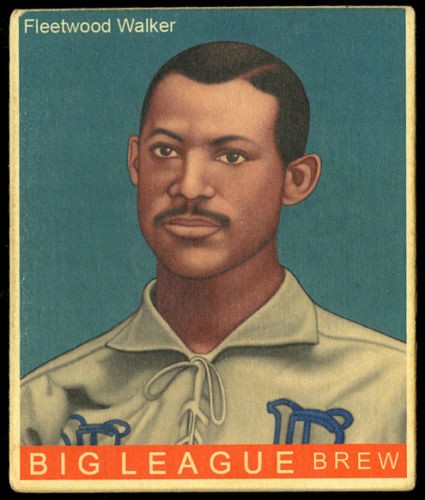
As New Jersey’s leading center of population and commerce in the 19th century, Newark was home to more than a dozen semipro teams dating back to the 1850s. Starting in the 1880s, the city fielded teams in the minor leagues, including the Eastern League, International League, Atlantic League and Central League. In 1887, the Newark Little Giants of the International Association signed catcher Moses Fleetwood Walker (right) and pitcher George Stovey. Both were African-American.
Stovey is regarded by some baseball historians as the most talented player of the 19th century not in the Hall of Fame. According to legend, the Chicago White Stockings agreed to play an exhibition match against the Little Giants, not realizing they had black players on the team. When Chicago’s captain, Cap Anson, saw Stovey he demanded that he leave the field or the game would not be played. Not wanting to lose its cut of the gate—and fearful of the powerful Anson— Newark benched Stovey, marking the unofficial start of the “color line” in organized baseball. Walker was equally significant to baseball history. Three years earlier, he had played for Toledo of the American Association, which at the time considered a major league. The next time an African-American player would take the field for a major-league team would be Jackie Robinson, in 1947.
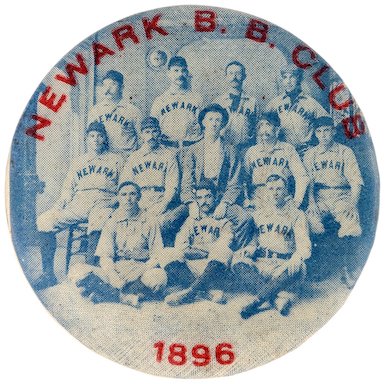
In 1888, the Newark Trunkmakers gave the city its first pennant after edging Jersey City in a neck-and-neck battle. The Trunkmakers had an 83–23 record and, at .783, the best winning percentage of any minor-league club in the 1800s. Their manager, a Newark-born jeweler named Christian Meisel, had been managing minor-league and semirpro teams in the northeast for several year. Jersey City, at .771, had the best percentage of any second-place team in the history of professional baseball. Longtime baseball man Pat Powers managed the Skeeters. In 1896, the Newark Colts (left) won the Atlantic League pennant. They were managed by Tom “Oyster” Burns, who had managed Newark clubs in the 1880s. Neither of these champions, however, was able to translate success into profit, and they both blipped out of existence shortly after their victories.
SAILORS & INDIANS
In 1902, the Eastern League granted another franchise to Newark. The team’s name through 1907 was the Sailors. The 1902 Sailors featured a pair of 22-year-olds who would go on to star in the majors. Matty McIntyre had seen action with the Philadelphia A’s in the first year of the American League, but was cut by Connie Mack in 1902 and caught on with the Sailors. He returned to the big leagues with the Tigers and played beside Ty Cobb in the outfield for three Detroit pennant winners. He began the year in Newark and finished with the Buffalo Bisons after an in-season trade. Infielder Art Devlin began his pro career with Newark after graduating from Georgetown University. In 1904, he was purchased by the New York Giants and manned third base across the river in the Polo grounds for eight seasons. In 1905, he tied for the NL lead with 59 stolen bases. He swiped three more bags in the World Series that fall.

The Sailors were managed by Walter Burnham. Burnham was a well-regarded minor-league skipper who managed 22 seasons, including six in Newark. Among the other talented players he directed with the Sailors were Heinie Wagner—who played four years for Newark before becoming one of the better shortstops in the game for the Red Sox—and Oscar Stanage, who caught for the Tigers for a decade. Two future Hall of Famers played part of a season for Burnham in Newark. The Sailors were the final minor-league stop for spitballer Ed Walsh, who spent half a season in Newark in 1903. By 1906, he ranked among the AL’s top pitchers. That fall, he won two games for Chicago in the World Series. Walsh won 40 games in 1908 and finished with 195 victories. He went into the Hall of Fame in 1946. Eddie Collins (right) played four games for Newark in 1907 as a 20-year-old. He had been kicked off the Columbia University team for playing professionally in 1906 under an assumed named. He finished the 1907 season with the A’s and, in 1908, became their everyday second baseman. Collins played in the big league 25 years and finished his Hall of Fame career with 3,315 hits and a .333 career average.
In 1908, George Stallings took over as Newark manager and the team was renamed the Indians. A veteran minor- and major-league manager, Stallings had been out of baseball in 1907 tending to his farm in Georgia. He managed one year in Newark before going across the Hudson to take over the New York Highlanders. Later, he gained fame as the skipper of the 1914 Miracle Braves. One of Stallings’s players on the Indians was 20-year-old Paul Krichell. Krichell would go on to become one of the great talent scouts in baseball history. Working for the Yankees, he signed four Hall of Famers: Lou Gehrig, Tony Lazzeri, Yogi Berra and Whitey Ford.
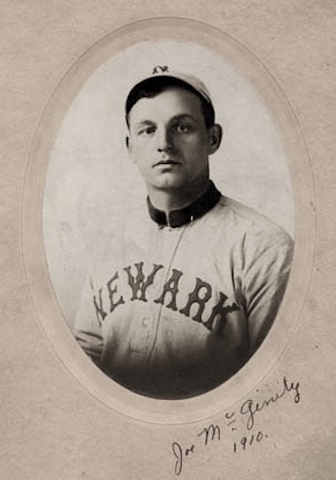
In 1909, 38-year-old Joe “Iron Man” McGinnity (left) joined the Indians and was named player-manager during the season. He won 29 games as a pitcher for Newark and led the club to a second-place finish. The future Hall of Famer won 30 games the next year and managed the team to another second-place finish. The 1910 season also marked the arrival of meteoric Rube Waddell. He won 5 of 8 decisions for Newark after being released by the St. Louis Browns in August.
Newark moved to the International League in 1911 and, in 1913, they won the IL pennant behind new manager Harry Smith. Smith, who was born in Yorkshire, England, had just wrapped up his big-league career as a catcher, mostly for the Pirates and Braves. Virtually every player on the 1913 roster was a major league-caliber player. Some were on their way up, others on their way down. The top hitter was Hub Northen, a stocky outfielder who began the year with Jersey City. A year earlier, Northen had been the everyday center fielder for Brooklyn. Newark’s leading pitchers were Raleigh Aitchison and Watty Lee, who combined for 43 victories. The veteran Lee had been one of the team’s best starters for a couple of years and would remain so for a couple more. Contributing 4 wins to the Indians total that season was 20-year-old Al Schacht, who would go on to fame as the Clown Prince of Baseball.
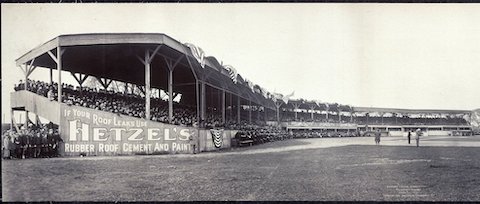
The Indians were a popular team and a solid draw at their field, Wiedenmayer’s Park (right). But in 1915, the bottom fell out. Oil magnate Harry Sinclair had purchased the champion Indianapolis Indians of the Federal League with the idea of taking on the Giants and Yankees in New York City. Unable to secure a playing field, he moved the team to Harrison and called them the Newark Peppers. The Peppers had some of the top stars in the big leagues and, although they did not draw particularly well, they drew well enough to force the Indians out of Newark. The Indians moved to Harrisburg, Pennsylvania at the beginning of July, ending an eventuful era in New Jersey baseball. The Federal League folded in 1916, leaving the Jersey City Skeeters as the state’s top professional ball club.
ENTER THE BEARS
Newark did not remain team-less for long. In 1917, the International League granted the city another franchise and the Bears were born. For 15 years, the Newark Bears functioned as an independent club; later, they were purchased by the Yankees and became one of their top farm teams. In 1918, the team’s manager was future Hall of Famer Tommy McCarthy. It was his one and only stint as a manager. During a game that summer, McCarthy inserted himself in the lineup as a pinch-hitter. He drilled a single and was thrown out in a mad dash for second base. McCarthy, a noted baserunning daredevil during the 1890s, was 55 that season.
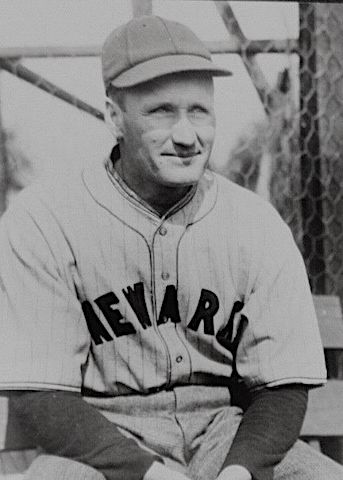
The Bears left Newark in 1920, as the owners moved the franchise to Syracuse. In 1921, however, the Bears were back in business, as the league’s Akron club moved to Newark and assumed the old team’s moniker. Two of baseball’s greatest names were associated with the Bears during the years that followed. In 1928, the team hired Walter Johnson (left) to manage the Bears. He spent one season in Brick City before returning to the Washington Senators as their manager. In 1929, the Bears hired the recently retired Tris Speaker as player-manager. He stayed for two seasons and as a part-timer was the team’s best hitter, despite being in his early 40s. Speaker’s first baseman in 1929 was 36-year-old Wally Pipp—the man who had been famously replaced in the Yankees’ lineup by Lou Gehrig four seasons earlier.
A handful of Bears during those early years went on to bigger and better things, most notably pitcher Eddie Rommel. Rommel was one of the first players to master the knuckleball, and put up numbers as a big leaguer that elevated him to the precipice of the Hall of Fame. After his pitching career, Rommel became one of baseball’s most highly regarded umpires. Another umpire, Jocko Conlon, played for the Bears for two seasons and did make the Hall of Fame—as an umpire. Conlon batted over .300 both years. Lew Fonseca played one year for the Bears, in 1926. Three seasons later, he won the AL batting title with the Cleveland Indians. Jo-Jo Moore of the Giants was in need of a little seasoning and played the outfield for Newark in 1931. He went on to become a six-time All-Star for the Giants. On that same Bears team was Billy Werber, who had been farmed out by the Yankees. He returned to the big leagues and led the AL in stolen bases four times.
HERE COME THE YANKS
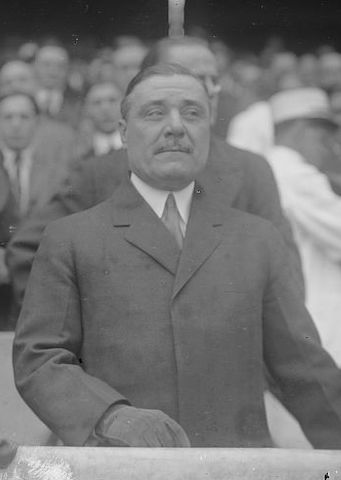
The 1932 season was a turning point for Newark baseball. Jacob Ruppert (right), owner of the Yankees, bought a controlling interest in the Bears and used the club to incubate talent for his big-league roster throughout the 1930s. In 1932, the Newark lineup featured future All-Stars Dixie Walker, Red Rolfe and George Selkirk. Other soon-to-be stars that came through Newark in the mid-1930s included relief ace Johnny Murphy and Spud Chandler. The Bears won three consecutive International League pennants from 1932 to 1934.
The 1937 team represented the apex of minor-league ball in the Garden State. Under manager Ossie Vitt (left), the Bears won 109 games against just 43 losses. Their star player was 20-year-old Charlie Keller, who led the IL with 189 hits, 120 runs and a .353 average. Right behind Keller in runs scored was 22-year second baseman Joe Gordon, who went on to enjoy a Hall of Fame career with the Yankees and Indians. Gordon was also the IL runner-up in home runs, with 26. Babe Dahlgren, the man who would replace Lou Gehrig after 2,130 consecutive games, was another star of the 1937 Bears.
Following the regular season, Newark faced the Louisville Redbirds—winners of the American Association pennant—in the Little World Series. The Bears came back from a 3 games to 0 deficit to win in 7 games. Their four straight wins came on a 1–0 shutout by Atley Donald followed by three blowouts. As one Star-Ledger reporter put it, “It was, in our opinion, the most dramatic triumph in the recent history of baseball—or any sport.”
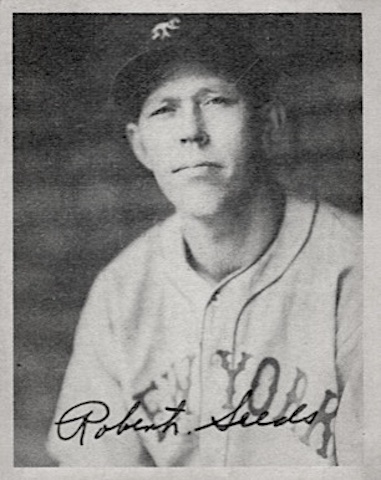
The 1938 Bears might have been an even better team than their predecessors, despite losing their popular manager to the Cleveland Indians. The Yankees replaced Vitt with Johnny Neun, one of the heroes from the teams of the early 1930s. As in 1937, the 1938 Bears had a double-digit lead by July 1 and won the pennant by a mile. The keys to their success included another dominant season by Keller and a league-leading .387 average by catcher Buddy Rosar, who overcame an early season beaning. However, the performance of the year was turned in by veteran center fielder Bob “Suitcase” Seeds (left). In two games against Buffalo, he hit seven homers, including four in successive innings—a feat never equaled in pro baseball. Seeds reached base safely 10 of 11 times and drove in 17 runs in the two games—and did so with a borrowed bat! He amassed 28 home runs in the first two months of the 1938 season, which projected to more than 70 for the year. Newark fans never got to see how the real math worked out because the Giants bought Seeds for $40,000 and brought him to the Polo Grounds to finish the year. He hit 9 more homers in the big leagues. The 1938 Bears scored 100 more runs than the 1937 club and hit six more homers, but won five fewer games, finishing with a record of 104–48.
The 1941 Bears also reached triple-digits in wins, finishing 100–54, and rank among the all-time great minor-league teams. Neun was still the skipper. He oversaw a roster that included Tommy Holmes and Frank Kelleher. Holmes would set an NL record in 1945 with a 37-game hitting streak that lasted until Pete Rose came along. Kelleher was a legendary minor league slugger who finished with more than 350 homers, but never made much of a splash in the majors. Johnny Lindell and Tommy Byrnes led a solid pitching staff. Both would make important contributions to Yankee pennant runs in the 1940s.
The Bears won two more International League pennants, in 1942 and 1944—making it 8 in 13 seasons under Yankee ownership. In the years after World War II, the combination of growing affluence, television and car ownership gave Newark fans more entertainment options, and suddenly Ruppert Stadium and its surrounding Ironbound neighborhood became a less appealing destination. After the 1949 season, the Yankees decided to divest themselves of the Bears. They sold the team to the Cubs, who moved the team to Springfield, Massachusetts.
OUT OF HIBERNATION
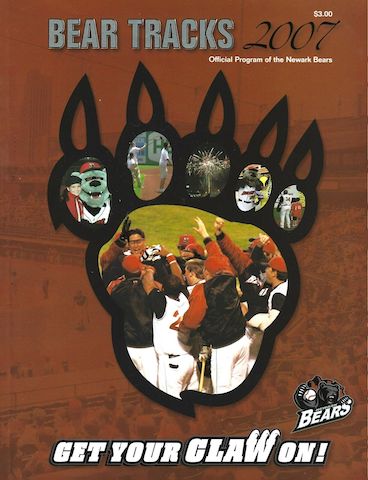
In 1998, former Yankees All-Star and Newark native Rick Cerone formed a team in the Atlantic League and resurrected the old Bears name. The club played its first season in Bridgeport, Connecticut while waiting for its new stadium to be completed on Broad Street in the northern part of Newark. Midway through the 1999 season—after playing their home games at Skylands Park in Sussex County—the Bears opened Bears & Eagles Riverfront Stadium, honoring the name of the city’s old Negro League champion.
The Bears functioned as an independent club, relying on ticket sales and sponsorship revenue generated by a mix of young hopefuls and former major-league stars hoping for another shot at the big time. They enjoyed their first winning season in 2000, with a 74–66 record. The Atlantic League season was split into two halves to maintain fan interest and, in 2001 and 2002, the Bears won the first half each time—and went on to win the league championship. They repeated as champions in 2007 under first-year manager Wayne Krenchicki, a native of Ewing Township.
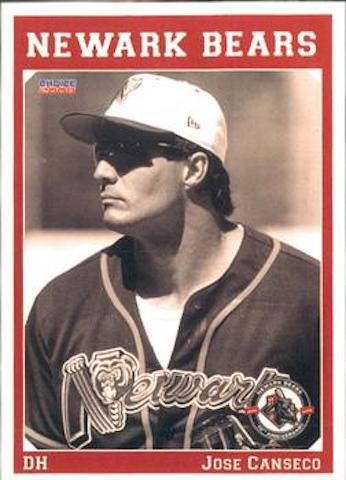
Among the recognizable stars who donned the Bears’ uniform were Jose Canseco (left) and his twin brother, Ozzie, Rickey Henderson—who parlayed his Newark stint into a contract with the Dodgers—and Jose Lima, who pitched well for the Royals after resurrecting his career the Bears. Other former big-leaguers who played for Newark included Carl Everett, Ruben Mateo, Randall Simon, Daryle Ward, Bobby Hill and Rob Mackowiak.
During their first decade of play, the Bears had six winning seasons. Unfortunately, success on the field did not do much for their bottom line. Following the 2008 season, the team filed for bankruptcy. A new ownership group, led by the team’s former GM, emerged to rescue the club and keep it going. The Bears moved to the Can-Am League in 2011, but failed to draw the 2,500 fans per game it needed to cover expenses and ceased operations following the 2013 season. In the years that followed, there was interest in restarting the Bears, but the new stadium—which had been funded by Essex County taxpayers—had been allowed to fall into disrepair, scaring off potential owners. Ultimately, though, it was a territorial dispute between the Yankees and Mets that made a Newark team unworkable, as neither would permit the other to locate an affiliate there.